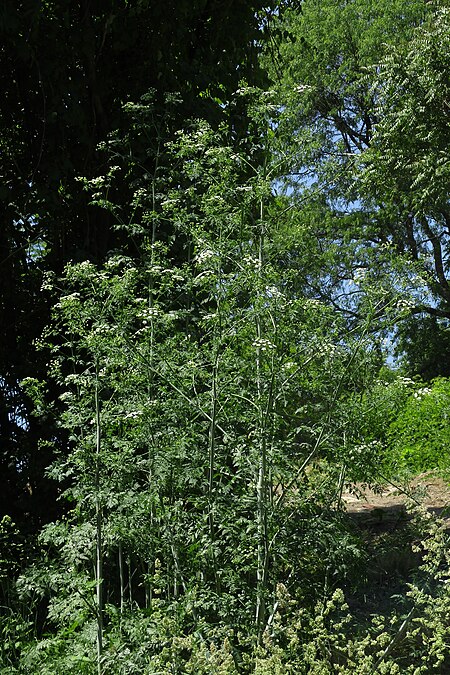
A foreign invader that likes damp, shady spots, this plant can be found in abundance in the stream valleys in Schenley Park.
For a description of the species, see the Aegopodium podagraria reference page.

Comments

A foreign invader that likes damp, shady spots, this plant can be found in abundance in the stream valleys in Schenley Park.
For a description of the species, see the Aegopodium podagraria reference page.


Mid-spring flowers are at their peak in the woods, but some of the earlier spring flowers are still blooming.








Poison Hemlock grows very tall very fast. It bears innumerable compound umbels of flowers like Queen Anne’s Lace, but the plants are much larger (and of course much more poisonous), usually with a whitish bloom on the stalks. It was almost certainly introduced into this country intentionally, which tells us more about our ancestors than we wanted to know.

These plants were growing in South Side Park, where they were photographed May 30.

For a fuller description, see the Conium maculatum reference page.

Goutweed is a popular groundcover that has gone native. It likes shade and damp areas, and it can take over large tracts of wet forest. The compound umbels (that is, flat-topped clusters of flat-topped clusters) of flowers will remind you of its relative Queen Anne’s Lace (Daucus carota); the leaves bear a superficial resemblance to elderberry leaves, and the flower umbels to elderberry umbels, whence Goutweed is also known as Ground Elder. It blooms in late spring. Some of the plants in these pictures were found in Bird Park, Mount Lebanon, and the others in West End Park.

The plants are similar to Spotted Cowbane (Cicuta maculata), and Father Pitt has misidentified them in the past. Here are differences to look for:
Spotted Cowbane has purplish stems or stems “streaked with purple” (says Gray); Goutweed has green stems.
The stalks of Spotted Cowbane are fatter than the stalks of Goutweed.
The flower clusters or “compound umbels” of Spotted Cowbane are more numerous and sloppier (“pedicels very unequal”) than the compound umbels of Goutweed.
Finally, Goutweed tends to grow in large and dense colonies, which is why it was popular as a ground cover.


Gray describes the genus and the species:
AEGOPÔDIUM L. GOUTWEED. Fruit ovate, glabrous, with equal filiform ribs, and no oil-tubes; stylopodium conical and prominent; seed nearly terete. — A coarse glabrous perennial, with creeping rootstock, sharply toothed ovate leaflets, and rather large naked umbels of white flowers. (Name from aix, goat, and podion, a little foot, probably from the shape of the leaflets.)
A. podagrària L. —Waste-heaps, etc., e. Mass. to Del. (Adv. from Eu.) [It has since spread further, mostly by escaping from gardens.]

It’s harder than it ought to be to find information about this species: many standard wildflower books skip it, but it is abundant in Frick Park, where it forms huge colonies. These plants were blooming in late May. Greenish-yellow flowers with very long (in proportion to the flower) stamens and lower leaves with five roughly equal leaflets are distinguishing marks. Other species of Black Snakeroot around here have white flowers and compound leaves with the lower pair of leaflets split almost to the base.
Gray describes the genus and the species:
SANÍCULA [Tourn.] L. SANICLE. BLACK SNAKEROOT. Calyx-teeth manifest, persistent. Fruit globular; the carpels not separating spontaneously, ribless, thickly clothed with hooked prickles. — Perennial rather tall glabrous herbs, with few palmately lobed or parted leaves, those from the base long-petioled. Umbels irregular or com pound, the flowers (greenish or yellowish) capitate in the umbellets, perfect, and with staminate ones intermixed. Involucre and involucels few-leaved. (Name said to be from sanare, to heal; or perhaps from San Nicolas.)
Styles much exceeding the bristles of the fruit, recurved.
S. gregària Bicknell. Stem slender, 6 dm. high; leaves 5-foliolate; leaflets obovate, cleft and serrate; fruit only 3-4(-6) mm. long, somewhat stipitate. — Rich woods, St. John Valley, N. В.; s. N. H. to Minn., Ark., and Ga.
